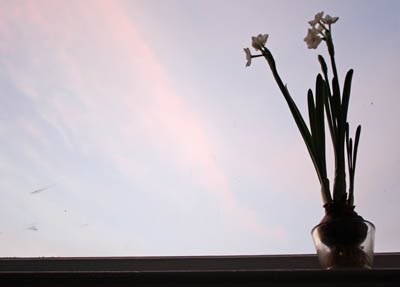
When Betty came to visit, she gave me a single paperwhite bulb. I didn't have a proper container to force it, so I jury-rigged one out of a votive holder and some tin. Within a few days of being given water, the roots began to reach down and a tiny green shoot began to work its way out. This week, the flowers bloomed, and looking at them brings me peace. The plant is so fragile just floating there, but so pretty, too.
After taking this photo, I deleted some recent shots to make more room on the memory card. Other photos have remained on the card for months, to stay indefinitely. Even though they've been downloaded and saved online, I worry that those copies might somehow get lost in a hard drive crash or a data outage. I cannot bring myself to remove the files from my camera, because it feels like I'd be erasing the people in them, too. How can I look at the last photograph of my father and press delete?
I like — perhaps need — to collect tiny pieces of people. That makes me sound like a serial killer, but you know what I mean. I have a box of souvenirs: photo booth strips, emptied matchbooks, a scrap of my grandfather's tie, a gelato wrapper, a thread from a wool dress, an expired RATP ticket, an origami crane, a drawing on a post-it, lakes cut out from a topographic map, a pressed maple leaf from the day my father died. I feel compelled to pour the importance of a moment into something small and tangible, so I can hold it and prove to myself that it existed.
When it comes to our autobiographies, we are all unreliable narrators. Our minds translate personal fictions into personal truth. So this is why, when I click the camera's wheel backward and spin backward into time, I linger on those photographs. They are evidence, they are a link to the past, and in some cases they're all I have left.
0 Responses to “In search of lost time”
Post a Comment